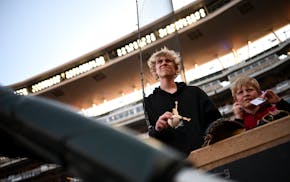Pitch-tracking data in baseball has had a profound effect on the sport and how we think about borderline pitches.
On a called strike three in a tight situation, it has changed the prevailing wisdom from "that pitch was too close to take," which gives the benefit of the doubt to both the umpire and the pitcher, to "that was close, but the tracker says it was a (ball or strike)."
The latter puts a great deal of pressure and blame on umpires while definitely identifying a wronged party — either the batter who had a ball incorrectly called a strike, or a pitcher who had a strike incorrectly called a ball.
I suspect this evolution, plus the fact that balls and strikes are not reviewable plays, has added greatly to the tension between umpires and players (and fans watching those little strike zone boxes on their high-definition TVs).
It's one thing to think you were wronged. It's another to go back and see evidence-based data that confirms it.
A study out of Boston University looked at the past 11 MLB seasons — tracking nearly 4 million pitches — came away with some interesting conclusions. Isolating just on 2018, the study found that umpires missed 34,294 ball-strike calls — about 14 per game. Even the best umpires miss about 7% of ball-strike calls, while the worst are around 11%.
The missed calls are typically spread out through a game. Some have little impact; some have a lot. There are enough of them that you imagine they tend to even out over time in terms of who they benefit.
Where they get magnified is in the high-leverage moments — late in close ballgames. An obvious moment went in the Twins' favor Tuesday. What you might not know is that a more subtle one also helped fuel their three-run rally and 6-5 victory.
First, the obvious: With the Twins leading 6-5 in the top of the ninth, Trevor May gave up back-to-back singles and then ran the count full against the dangerous Edwin Encarnacion.
May fired a 96-mph fastball in the vicinity of the outside corner. MLB StatCast showed the pitch was a little off the plate, but it was called strike three.
Too close to take back in the day. An outrage to some now.
But the impact was undeniable. Instead of having the bases loaded and nobody out, the Mariners had first and second with one out. The site gregstoll.com, using data from almost 60 years of MLB history, tells us that a team with the bases loaded and no outs is expected to score on average 2.25 runs and has an 84% chance of scoring at least one run.
So the expected would have given Seattle a 7-6 lead; the very likely outcome would have at least tied the game. But with first and second and one out? A team is held scoreless 59% of the time and is expected to score, on average, 0.9 runs. May produced the most likely result after the break, retiring the next two hitters to seal the win.
The Twins had the lead in the first place thanks to three runs in the eighth. After Max Kepler doubled, Jorge Polanco came to bat. Data suggests the first pitch to Polanco, which was called a ball, should have been called a strike.
Baseball Reference tells us that MLB hitters this season have a .383 on-base percentage this season (and .848 on-base-plus-slugging) after the count reaches 1-0, but those numbers dip to .263 and .621 after the count is 0-1. Sure enough, Polanco took another ball and then ripped a double that was central to the Twins' comeback.
The solution to this inequity? Either clamor for automated ball-strike calls until they happen … or live with the human element of umpiring and the notion that things even out over time. Screaming that the umps aren't as good as the machines, though, isn't going to solve anything as long as the umps are still making the calls.
Webb Simpson offers to resign from PGA Tour board. But only if McIlroy replaces him, AP source says

Live: Twins vs. White Sox. Follow the action on Gameview
![Glen and Becky Taylor during game 1 on Saturday, April 20, 2024, at Target Center in Minneapolis, Minn. ] CARLOS GONZALEZ • carlos.gonzalez@startri](https://arc.stimg.co/startribunemedia/X74AVHP3ZBD4TPPPDJTNX5LN6M.jpg?h=91&w=145&fit=crop&bg=999&crop=faces)
Gameview: Wolves vs. Suns in Game 2. Up-to-the-second updates here.
Paris main airport unveils new baggage handling system ahead of the 2024 Olympics

